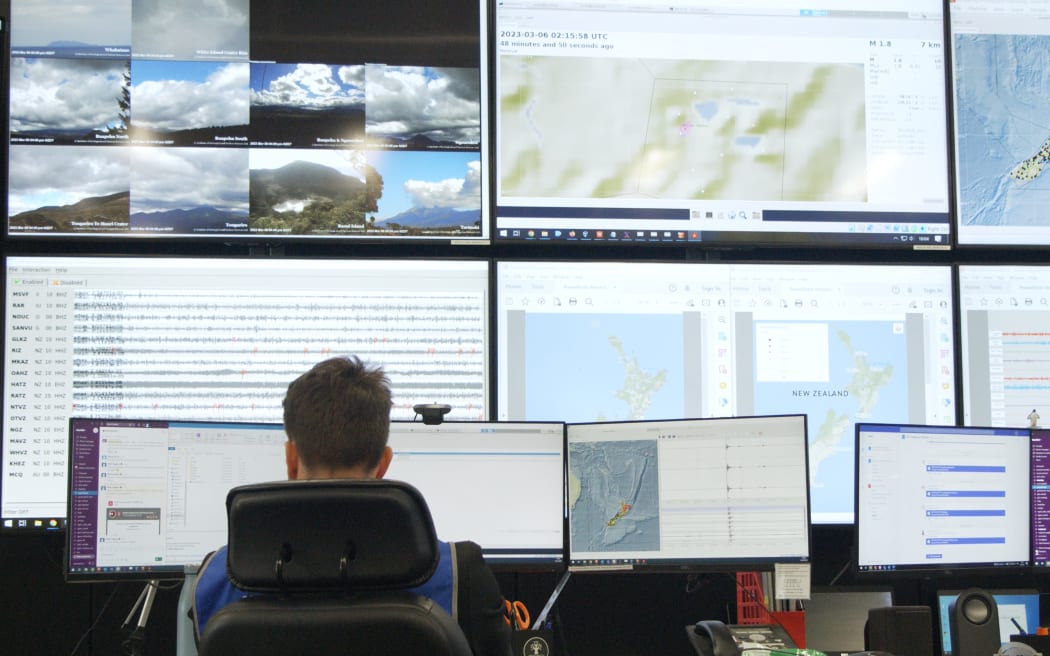
Inside the GNS National Geohazard Monitoring Centre. Photo: Supplied / GNS
Moments before a magnitude 7.6 earthqake rattled Japan's west coast, triggering an evacuation order for about 100,000 people, the public received a phone alert - warning them to brace for the shakes.
In the aftermath of the 1 January quake, despite the wide-spread devastation to land and structures, the number of casualties has been relatively low.
But had the nation been less prepared, the earthquake may have caused greater destruction.
Japan, located between four tectonic plates, is one of the most seismically active nations in the world.
Comparatively, New Zealand sits on two tectonic plates and both countries have offshore subduction zones capable of causing huge earthquakes that can produce a disastrous tsunami.
For both island nations, it is a matter of when, not if they will experience the seismic tremors.
But Victoria University geophysics professor John Townend said seismologists will likely never be able to determine when an earthquake will hit with any degree of precision, and because of that, society needs to prepare beforehand.
"We have to assume any earthquake will happen unexpectedly and so we must put things in place to be as resilient as possible," he said.
"This involves building earthquake-resilient infrastructure and putting in place newer technologies such as early warning systems."

GNS and EQC fault line researchers at Te Puninga. Photo: Supplied / EQC
What we can learn from Japan
Townend said Japan's early warning system is "likely the international best practice".
It has been operating for more than a decade.
During the magnitude 9.0 earthquake in 2011, alerts were sent to several million people near the epicentre about 15 to 20 seconds before severe shaking began.
About 90 percent of those people were then able to take advance actions to save their own and family member's lives, evacuating before a devastating tsunami took out coastal towns.
GNS Seismic duty officer Elizabeth Abbott said: "The effectiveness and value of a system like this in New Zealand is an active research topic for researchers across the country."
Townend said early warning systems have multiple components.
"You have to know an earthquake is happening, recognise it, work out if it's a big one, then you have to communicate that message efficiently through various mechanisms and then have society respond appropriately."
There is one system already running in Aotearoa; by Google on Android devices.
"But as of yet, we haven't really seen what the operating landscape is for a national system like that; who's in charge, and if people start taking measures in response to emergency messages that incur cost - who's responsible if it's a false alarm," Townend said.
National Emergency Management Agency (NEMA) civil defence and emergency management director John Price said early warning systems are often very expensive to implement and may provide little-to-no warning in some cases.
"Any earthquake early warning system would need to work with Aotearoa's geography, population distribution and emergency response systems, and would need to balance the cost of building and maintaining such a system against the benefits of receiving early warnings."
In contrast, Townend said Japan has a huge population base, with regular big earthquakes and "more money".
"It has a very large observational network. It can detect earthquakes very quickly, characterise them and push those early warning messages out"
"We are not in the same place."

GNS and EQC fault line researchers at Te Puninga. Photo: Supplied / EQC
But investing in such systems can reduce the cost of damage in the long term.
Although New Zealand does not yet have an advanced early earthquake system like Japan, EQC has been funding low-cost early warning systems.
Toka Tū Ake EQC chief resilience and research officer Dr Jo Horrocks said this is "progressing well".
For example, a number of low-cost seismometers were sourced and hosted by "citizen seismologists".
These cheaper sensors, bought for less than $100 each, can be deployed in large numbers, Townend said.
"When you have thousands of them, then what you lack in sophistication of the sensor, you make up for in the number."
There was also opportunity to design early warning systems that address particular needs.
For example, Townend said these could be geographically based, or to warn commercial sectors so factories can take steps to avoid being damaged when shaking starts, or warn hospitals to begin immediate preparations for those injured.
Mexico City has one such operating system, where early warnings of strong shaking are provided to the city's residents caused by earthquakes triggered throughout Mexico.
"Each system is a little different as well. Every different geographic area, every different jurisdiction has different needs and populations. It's not the case that you can take the Japanese model, which is probably the bees knees, and just export that. It requires a lot of customisation," Townend said.
There was work also being done by GNS Science to understand what earthquakes New Zealand could prepare an early warning system for.
The 2011 Christchurch earthquake that killed 185 people occurred close to the ground surface and the waves triggering seismometers were also the waves shaking the buildings.
"So in a situation like that, there's very little time for getting a message out to the nearest affected populations," Townend said.

Researchers from GNS and EQC at the Wairarapa subduction zone. Photo: Supplied / EQC
Earthquake ready society
In the last century, New Zealand's earthquake records have been different to Japan.
In the first 100 years after the signing of Titiri o Waitangi in 1840, Aotearoa experienced a number of large earthquakes such as in Wairarapa and Murchison.
"But in the time that most people currently alive have been alive, since about the 1950s, it's been relatively quiet," Townend said.
"I think in that period, New Zealand did become a little less familiar with what earthquakes are like and with the consequences like aftershocks and liquefaction … We'd become a little bit more complacent."
But recent events in the past two decades have shaken Kiwis awake to the risks they face.
Horrocks said many lessons were learnt after the Canterbury earthquake sequence.
"Based on this wealth of knowledge, New Zealand now has some of the strongest seismic building requirements in the world, to protect people and property."
Toka Tū Ake EQC invests more than $10 million each year in natural hazards research, including public engagement.
NEMA runs annual Drop, Cover, Hold campaigns and there was also the ShakeOut exercise, where last year, 650,000 Kiwis practised their earthquake drills.
Specific at-risk communities were also targeted with education initiatives such as the AF8 roadshow, the East Coast LAB workshops and It's Our Fault in Wellington.
"There are new technologies developing all the time, new ways of detecting waves, things are changing very rapidly, so the next big earthquake that happens in New Zealand, we will certainly be better prepared than we were for previous things," Townend said.
"But we can't rest on our laurels, we have to keep on learning."

